The NVIDIA GeForce RTX 2080 Ti & RTX 2080 Founders Edition Review: Foundations For A Ray Traced Future
by Nate Oh on September 19, 2018 5:15 PM EST- Posted in
- GPUs
- Raytrace
- GeForce
- NVIDIA
- DirectX Raytracing
- Turing
- GeForce RTX
Wolfenstein II: The New Colossus (Vulkan)
id Software is popularly known for a few games involving shooting stuff until it dies, just with different 'stuff' for each one: Nazis, demons, or other players while scorning the laws of physics. Wolfenstein II is the latest of the first, the sequel of a modern reboot series developed by MachineGames and built on id Tech 6. While the tone is significantly less pulpy nowadays, the game is still a frenetic FPS at heart, succeeding DOOM as a modern Vulkan flagship title and arriving as a pure Vullkan implementation rather than the originally OpenGL DOOM.
Featuring a Nazi-occupied America of 1961, Wolfenstein II is lushly designed yet not oppressively intensive on the hardware, something that goes well with its pace of action that emerge suddenly from a level design flush with alternate historical details.
The highest quality preset, "Mein leben!", was used. Wolfenstein II also features Vega-centric GPU Culling and Rapid Packed Math, as well as Radeon-centric Deferred Rendering; in accordance with the preset, neither GPU Culling nor Deferred Rendering was enabled.
| Wolfenstein II | 1920x1080 | 2560x1440 | 3840x2160 |
| Average FPS |  |
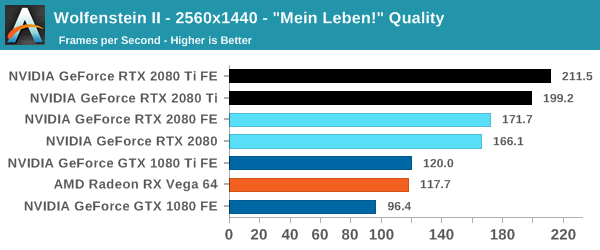 |
 |
| 99th Percentile | 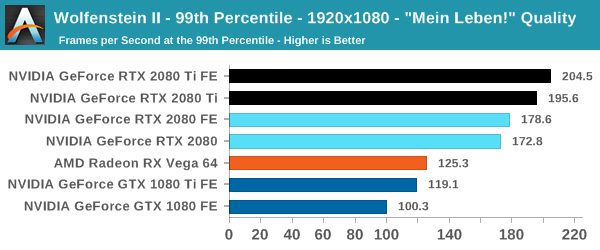 |
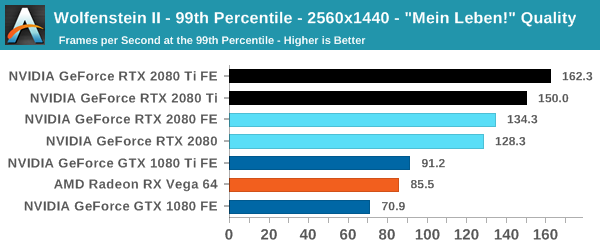 |
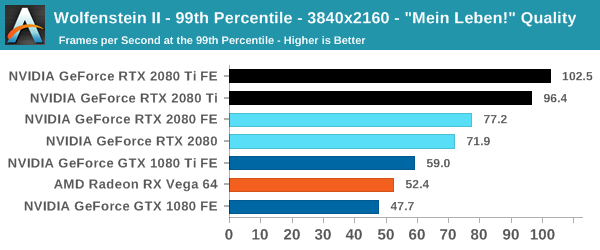 |
I am actually impressed with Wolfenstein II and its Vulkan implementation more than the absurd 250+ framerates, if only because many other games hold back the GPU because of the occurring CPU bottleneck. In DOOM, there was a hard 200fps cap because of engine/implementation limitations, a bit of a corner case, but manufacturers make 240Hz monitors nowadays, too. On a GPU performance profiling side, of course, reducing the CPU bottleneck makes comparing powerful GPUs much easier at 1080p, and with a better signal-to-noise than at 4K.
This is combined with the fact that at 4K, the 20 series are looking a huge 60 to 68% lead over the 10 series, and we'll be cross-referencing these performance deltas with other sections of the game. Even in the case of a 'flat-track bully' scenario where the 2080 Ti is running up the score, the 2080 Ti's speed compared to the 2080 is somewhat less than expected at 24 to 27%. It's a somewhat intriguing result for an optimized Vulkan game, as the game runs and scales generally well across the board; It's also not unnoticed that both the RX Vega cards and GeForce Turing cards outperform their expected positions, though without the graphics workload details it's hard to speculate with substance. With framerates like these, the 4K HDR dream at 144 Hz is a real possibility, and it would be interesting to compare with Titan V and Titan Xp results.


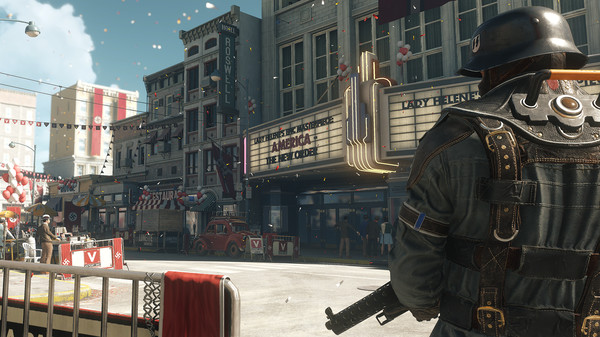









337 Comments
View All Comments
Spunjji - Friday, September 21, 2018 - link
If that were true then Nvidia could have left off the RTX parts this time around and created a GPU that offers a simple ~30% performance improvement at roughly the same retail cost.Following that, the die-area benefits from 7nm could have been spent on both RTX features and another ~30% performance boost at a similar or slightly-higher cost. By then they could probably have added enough resources to at least manage high refresh rates at 1080p, if not 2.5K
Instead they massively inflated their die for features that require you to accept resolutions and frame-rates that PC gaming left behind 6 years ago.
mapesdhs - Wednesday, September 26, 2018 - link
That last sentence is something I which tech sites would emphasise a lot more. It very much defines how those who normally buy into the higher tier tech now regard what they like doing and why. NVIDIA pushed hard to create the market for high-refresh gaming, 4K & VR, now suddenly they're trying to do an about-face. I can't see how it can work. I just bought a 27" 1440p IPS panel for 200 UKP, the cost of good screens has come down a lot, and now NVIDIA wants us to drop back down to 1080p? :D I get the impression the reaction of a great many is just laughter.Gastec - Thursday, September 27, 2018 - link
Ahaa! You are getting close :) Come on, just spell it: they want to "milk" us as much as possible before Moore's Law ends and we will completely stop upgrading our PC's and we'll just replace the defective part twice in a life time. No more billions of moneyz for Corporate Commander :)Yojimbo - Wednesday, September 19, 2018 - link
"Please, let's boycott Turing cards."Throw down your chains and resist!
Ranger1065 - Thursday, September 20, 2018 - link
100%Xex360 - Wednesday, September 19, 2018 - link
These cards are a disappointment for the price, the 2080ti should be priced at most 800$, it just doesn't offer the performance required for justifying its price, worse here they compared it to the 1080ti FE which as GamerNexus pointed out is not ideal, for the cards are noticeably slower than other cards with proper cooling, so the 1080ti is at least as fast as the 2080.On the ray tracing side, I like the technology but it's not impressive enough to justify the hefty price tag, I'd rather have a real generational leap with a 2070 beating a 1080ti and a 2080ti having at least 70% more performance than having RT, it's a niche product and obly few games will benefit from it, and the whole DLSS isn't good either limited to only a few games, with more brut force we could achieve 4k and super sampling.
kron123456789 - Wednesday, September 19, 2018 - link
"I'd rather have a real generational leap with a 2070 beating a 1080ti and a 2080ti having at least 70% more performance than having RT"That reminded me of a very old quote:
"If I had asked people what they wanted, they would have said ‘faster horses.’" — Henry Ford
saikrishnav - Wednesday, September 19, 2018 - link
That quote only makes sense if Nvidia came up with a "different" radical product than a graphical horse. They just made a slightly faster horse with a RTX ON button which nobody is ready to push yet i.e. developers. So, if you have a choice between a much faster horse and a RTX ON button - one would take a much faster horse. Now, when developers are ready to push the button/envelope, and sign on to the RTX, then this quote makes sense. Nvidia is asking customers to pay the price of new tech-adoption without show-casing the products that use it. They could have invested with devs and in games, to use the RTX, and then released it. But no, they want to fill in a gap until 7nm arrives.Yojimbo - Wednesday, September 19, 2018 - link
Nobody was ready to push the mass produced automobile button, yet, either. Do you think Ford started mass producing cars and then immediately there were roads and gas stations? No, at first horses could comfortably go many more places than cars could.His quote is entirely appropriate.
There is no gap to fill before 7 nm arrives since AMD will have no competition. NVIDIA introduced this now because they see value in the product which will generate sales. Plus it will get the ball rolling on developers implementing the new technologies that are present in the architecture and will be present in future NVIDIA architectures.
BurntMyBacon - Thursday, September 20, 2018 - link
Have to agree here. No only where automobiles extremely limited in where they could go on introduction, they were also very loud and considered disruptive to society with a large voice of opposition. These new cards at least have the benefit of being able to go anywhere their predecessors can while still enabling new capabilities.I very much agree that nVidia is using this architecture to "get the ball rolling" on the new tech. They are probably very much aware that sales of RTX cards will be lower until they can fit a meaningful amount of the new hardware resources into a mainstream chip. Though, given the size of the chips and typical associated yields, nVidia may still end up selling every chip they can make.